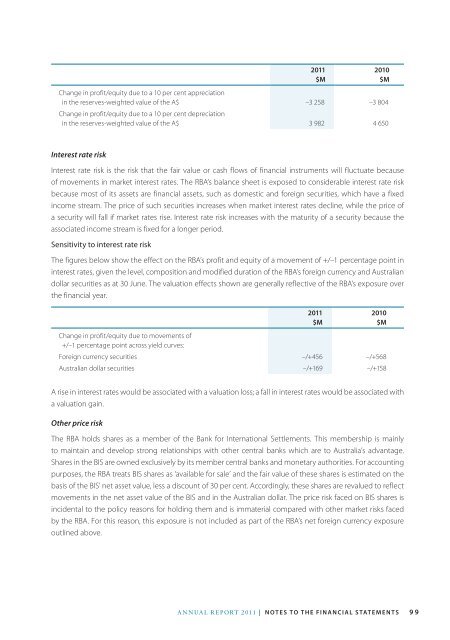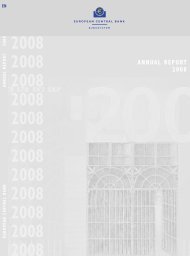Reserve Bank of Australia Annual Report 2011
Reserve Bank of Australia Annual Report 2011
Reserve Bank of Australia Annual Report 2011
Create successful ePaper yourself
Turn your PDF publications into a flip-book with our unique Google optimized e-Paper software.
Change in pr<strong>of</strong>it/equity due to a 10 per cent appreciation<br />
in the reserves-weighted value <strong>of</strong> the A$ –3 258 –3 804<br />
Change in pr<strong>of</strong>it/equity due to a 10 per cent depreciation<br />
in the reserves-weighted value <strong>of</strong> the A$ 3 982 4 650<br />
<strong>2011</strong><br />
$M<br />
2010<br />
$M<br />
Interest rate risk<br />
Interest rate risk is the risk that the fair value or cash flows <strong>of</strong> financial instruments will fluctuate because<br />
<strong>of</strong> movements in market interest rates. The RBA’s balance sheet is exposed to considerable interest rate risk<br />
because most <strong>of</strong> its assets are financial assets, such as domestic and foreign securities, which have a fixed<br />
income stream. The price <strong>of</strong> such securities increases when market interest rates decline, while the price <strong>of</strong><br />
a security will fall if market rates rise. Interest rate risk increases with the maturity <strong>of</strong> a security because the<br />
associated income stream is fixed for a longer period.<br />
Sensitivity to interest rate risk<br />
The figures below show the effect on the RBA’s pr<strong>of</strong>it and equity <strong>of</strong> a movement <strong>of</strong> +/–1 percentage point in<br />
interest rates, given the level, composition and modified duration <strong>of</strong> the RBA’s foreign currency and <strong>Australia</strong>n<br />
dollar securities as at 30 June. The valuation effects shown are generally reflective <strong>of</strong> the RBA’s exposure over<br />
the financial year.<br />
<strong>2011</strong><br />
$M<br />
2010<br />
$M<br />
Change in pr<strong>of</strong>it/equity due to movements <strong>of</strong><br />
+/–1 percentage point across yield curves:<br />
Foreign currency securities –/+456 –/+568<br />
<strong>Australia</strong>n dollar securities –/+169 –/+158<br />
A rise in interest rates would be associated with a valuation loss; a fall in interest rates would be associated with<br />
a valuation gain.<br />
Other price risk<br />
The RBA holds shares as a member <strong>of</strong> the <strong>Bank</strong> for International Settlements. This membership is mainly<br />
to maintain and develop strong relationships with other central banks which are to <strong>Australia</strong>’s advantage.<br />
Shares in the BIS are owned exclusively by its member central banks and monetary authorities. For accounting<br />
purposes, the RBA treats BIS shares as ‘available for sale’ and the fair value <strong>of</strong> these shares is estimated on the<br />
basis <strong>of</strong> the BIS’ net asset value, less a discount <strong>of</strong> 30 per cent. Accordingly, these shares are revalued to reflect<br />
movements in the net asset value <strong>of</strong> the BIS and in the <strong>Australia</strong>n dollar. The price risk faced on BIS shares is<br />
incidental to the policy reasons for holding them and is immaterial compared with other market risks faced<br />
by the RBA. For this reason, this exposure is not included as part <strong>of</strong> the RBA’s net foreign currency exposure<br />
outlined above.<br />
<strong>Annual</strong> report <strong>2011</strong> | notes to the financial statements<br />
99





![KNOW YOUR NEW GIBRALTAR BANKNOTES - [Home] bThe/b](https://img.yumpu.com/50890985/1/184x260/know-your-new-gibraltar-banknotes-home-bthe-b.jpg?quality=85)
![PAPUA NEW GUINEA - [Home] - Polymer Bank Notes of the World](https://img.yumpu.com/49758743/1/190x143/papua-new-guinea-home-polymer-bank-notes-of-the-world.jpg?quality=85)










